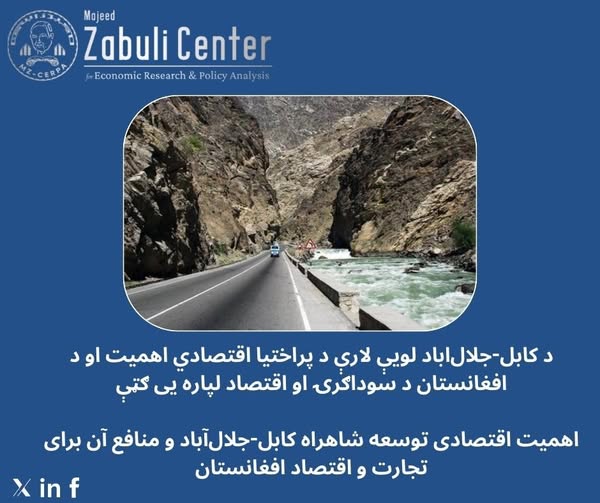23 Aug,25
Most Searched Keywords
04 Aug
The Economic Significance of Expanding the Kabul–Jalalabad Highway and Its Benefits for Afghanistan’s Trade and Development

The Kabul–Jalalabad highway is not only a crucial transportation route connecting Afghanistan’s capital to Jalalabad, but it also holds fundamental value for the country’s trade and economic growth. This highway directly links Kabul to Torkham, which serves as one of Afghanistan’s primary trade gateways with Pakistan. The construction of a second lane along this highway plays a strategic role in Afghanistan’s economic development by enhancing regional trade capacities and further solidifying the country’s position within international trade corridors.
This road is essential for facilitating trade exchanges between Afghanistan and Pakistan, which remains one of Afghanistan’s key trading partners. Through the Torkham, vital commodities such as food supplies, construction materials, agricultural products, and other consumer goods are imported and exported, feeding Afghanistan’s domestic markets. The addition of a second lane will significantly reduce travel time, congestion, and delays between the two countries, allowing for the more efficient movement of goods. This is particularly crucial for perishable goods like fresh fruits and vegetables, which require fast and safe transport to reach markets without spoilage.
Furthermore, enhancing transport infrastructure between Kabul and Torkham will play a significant role in strengthening the supply chain for essential goods in Afghanistan. This highway provides an effective link between Kabul and Pakistan’s industrial centers, ensuring a steady flow of commodities to urban markets, particularly in the capital. As a result, it will help prevent product shortages and contribute to price stability, allowing citizens better access to essential goods at affordable prices. Additionally, improved transportation networks will support domestic production by enabling Afghan producers to bring their goods to both local and international markets, thus encouraging agricultural and industrial development across the country.
Strategically, Afghanistan is a natural land bridge between South Asia and Central Asia. The development of the Kabul–Jalalabad road boosts the country’s potential role in broader regional trade initiatives, such as the China-Pakistan Economic Corridor (CPEC) and other projects linking Central Asia to Pakistan’s seaports. By enhancing this key route, Afghanistan positions itself as a vital transit hub in the region, attracting greater foreign investment and expanding its trade capacity with neighboring countries.
Economically, transport costs play a critical role in the competitiveness of commercial goods. Upgrading this highway will reduce operational expenses for transport companies and traders by saving on fuel, minimizing road accidents, limiting vehicle and goods damage, and cutting down on time lost due to traffic jams. These savings can improve the competitiveness of Afghan exports in global markets, increasing the country’s export revenues. Moreover, enhanced road safety reduces logistical losses and builds greater trust in Afghanistan’s supply chain systems.
The construction project also brings indirect economic benefits, especially in terms of employment creation and the stimulation of local economies along the highway. During the construction phase, it generates job opportunities for many workers, positively impacting the livelihoods of communities along the road. In the long run, improved roads pave the way for new businesses and services, including vehicle repair shops, fuel stations, and roadside stores that will cater to growing traffic volumes. These economic activities contribute to long-term development in both Kabul and Jalalabad and improve living standards for surrounding populations.
Importantly, the financing model for this infrastructure project is based on transparent use of collected taxes, which are stored in a dedicated bank account and managed by the Ministry of Finance. This approach demonstrates a sustainable commitment to infrastructure development without relying on external aid. If managed transparently and effectively, this model could serve as a blueprint for financing future large-scale infrastructure projects across Afghanistan.
Additionally, the increased capacity of the Kabul–Jalalabad highway will improve Afghanistan’s overall trade logistics, including customs efficiency, transport infrastructure quality, and the ease of cross-border transactions factors that are commonly used to evaluate a country’s performance in global logistics indices. Strengthened logistics will make Afghanistan a more competitive trade partner, attracting foreign investors and building greater economic resilience. This, in turn, will expand trade routes and increase the number of Afghan traders active in regional and global markets.
Ultimately, the development of the Kabul–Jalalabad highway marks a vital step in modernizing Afghanistan’s economic infrastructure. The second lane of this road not only represents an internal improvement but also a broader leap forward in Afghanistan’s regional trade integration. By enhancing the connection between Kabul and the Torkham trade route, the country boosts its trade capacity, stabilizes domestic prices, and sparks growth across multiple sectors. With a well-managed financing mechanism and continuous progress, this project has the potential to significantly transform Afghanistan’s economy and strengthen its role in global trade bringing long-term benefits to both local communities and national traders alike.
